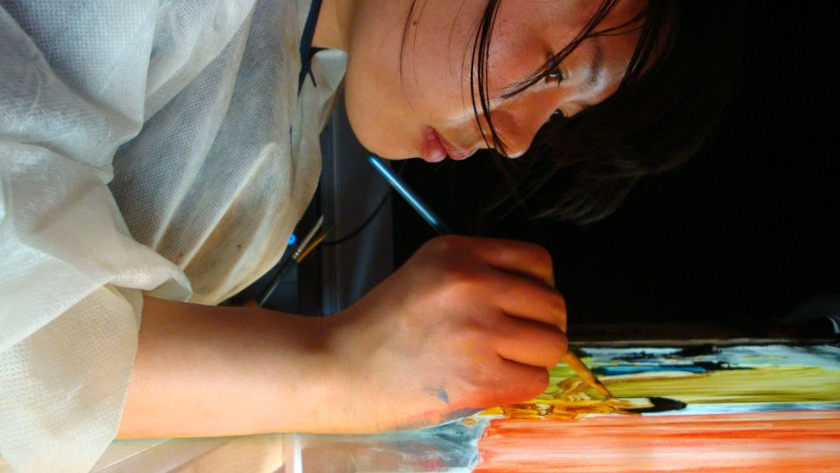Animated Trips Part II: Personal Souvenirs

The following article attempts to recreate my personal animated film festivals itinerary of 2016 when I had a great pleasure to visit following events: Animafest Zagreb 06.-11.06), Fest Anča (29.06.-03.07, Žilina, Slovakia), Animator (Poznań, Poland, 08.-14.07), Supertoon (Šibenik, Croatia, 24.-29.07.), Anibar (link: , Peja, Kosovo, 15.-21.08.), StopTrik IFF (Maribor, Slovenia, 27.-30.10., Łódź, Poland, 11.-12.11), Etiuda&Anima IFF (Kraków, Poland, 22.-27.11.), PAF (Olomouc, Czech Republic, 01.-04.12) and Animateka ( Ljubljana, Slovenia, 05.-11.12.).
Reviewing a festival seems as announcing personal judgement over sensitivities of the programmers, selectors and jurors, a highly subjective occupation. In the first part of this article, I referred to the notable choices of the international jurors gathered on the mentioned festivals. Out of 18 awarded titles Igor Kovalyov's Before Love, Marta Pajek's Impossible Figures and Other Stories: Part II and Špela Čadež's Nighthawk have been awarded most frequently.
2016 can be considered a truly good year for artistic animation, rich in challanging film works as well as courageous and wise signs of appreciation. Howeve,r the very nature of the festival rivalry leaves out a lot of impressive films.
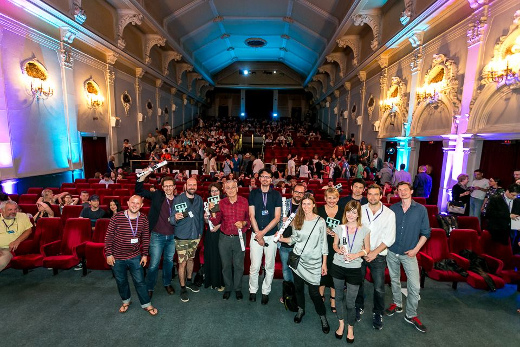
Animafest Zagreb winners 2016 (c) Animafest Zagreb
For this reason I will focus now on subjectively chosen works overlooked by the experts. And since one of the reasons behind the festival is to encourage the viewers to think critically, I will also share certain hesitations and call for adopting particular attitude in film culture activism, the ideas that derive directly from my personal festival experience of 2016.
PERSONAL SOUVENIRS
At StopTrik, I have granted myself a privilege of naming my individual Special Mention. This year I have felt huge attraction to Brazilian film Tango made by Pedro Giongo and Francisco Gusso. What I appreciate about Tango above all is its narrative sophistication.
Thorough reflection on destructive forces equally overtaking primal rituals and advanced mass culture is apparent and powerful. The chosen one indulges in gluttony only to eventually die from starvation, in the same manner as the whole community exploits resources and abuses the others only to become sick, frightened and defenseless.

Tango
Three wise monkeys whose task is to initiate the ritual again and again know how pathological are the moments of common happiness, and how disgusting become the moments of common misery. The authors play with the viewer's willingness to interpret the film as an adaptation of some well-known myth but here all the precisely crafted cut-out silhouettes and settings serve the purpose of intellectual deception.
We are familiar with all the elements, we realize where the story starts, where it finishes, why it has to return to its origins and unveils again, but this time it sews together attributes of modernity with images of phantasmatic tribal never-land, cut-outs painted in matt colours with disturbing ornaments, and consequently a repulsion is a mirroring reflection of a pity. And there is no way out.
Actually I have seen Tango for the first time on Animafest however from the festival in Zagreb I would prefer to point out Filipe Abranche's It Would Piss Me Off to Die So Yooooung...
Recent anniversary of the WWI outbreak has resulted in an eruption of the films on the subject, mostly following the same narrative and stylistics that recall 1957 Stanley Kubrick's masterpiece Paths of Glory, usually in an inefficient way, but It Would Piss Me Off... stands out in this category.
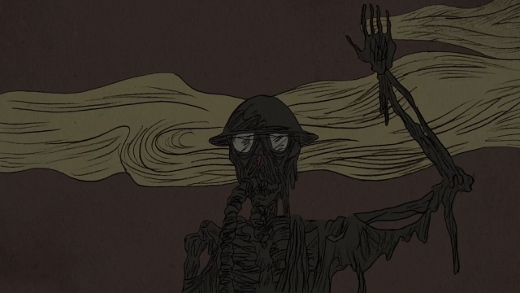
It Would Piss Me Off to Die So Yooooung...
Abranche's dim images constantly transform, defragmentation is overwhelming and dominates the narrative. It is again a story about the trenches, gas attacks and trauma of internecine combat. But all the elements serve the purpose of delineating fear. This major subject is manifested through decomposition of the images and wheezing sound effects.
Animal brutality is a twin of a fear and its truly mesmerizing depiction can be found in Shen Jie's Monkey (one of the highlights of Fest Anča).
Vibrating and pulsating 2D images refer to the tradition of animation of wash and ink painting. Repetitive violent acts are conducted by humanoid monkey or monkey-like human armed with a bat
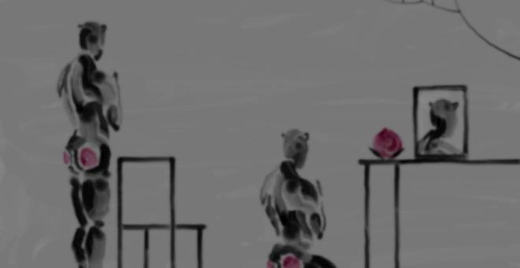
Monkey
Looped aggression in one - and everlasting - moment destroys sacrum of beauty, tradition and faith. All the visual elements are subjugated to two processes that are stylistically rich and highly symbolic on the level of interpretation, i.e. shattering and overturning. Apparently Far East artistic sensitivity speaks to me since another meaningful experiences come from Yi Zhao (Chinese animator based in The Netherlands), the author of Löss (lseen at Animator), and Qing Sheng Ang from Singapore, a director of Drop Nowhere (seen at Etiuda&Anima).
Yi Zhao combines dark cut-out with delicate sketches of set design to create a reality that seems to be suspended in time but with each slowly changing image the viewer realizes that the cruel story of slavery, sexual abuse and murder strongly relates to contemporary times. The silhouettes are rough, ponderous and dull, resemble wooden or mud figurines (the latter indeed play important part in the relation between a man and a woman).
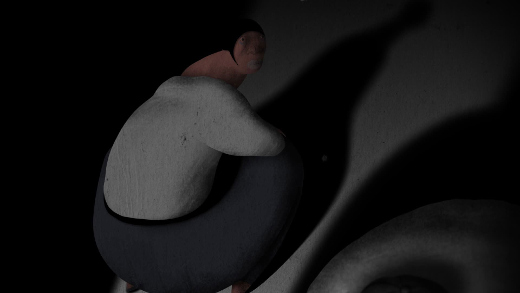
Loss
Plateau landscape leaves no hope, the horizon is dark and completely beyond enslaved woman's reach. Similarly to Chinese melodrama here the emotions are risen to the highest level, even exaggerated but Yi Zhao knows how to maintain the balance. A spectator's gaze is led by smooth editing, soft backgrounds and tender soundtrack.
Aesthetically Drop Nowhere is a complete opposite of Löss. 3D imaginary presents contemporary Singapore in the brightest daylight filled with urban buzz. An infant looks for his favorite toy that fell out from the window of the tall building. Unaware of the danger he goes down to the following balconies, rails and ledges, and only coincidental blasts save him from fatal fall.
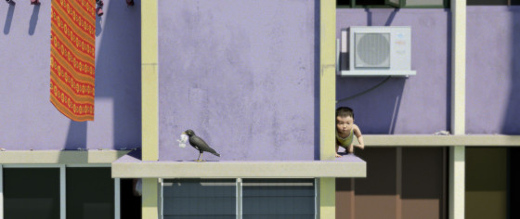
Drop Nowhere
Down the way he encounters inhabitants of the building, the migrants who constitute an urban tissue being at the same time invisible and unimportant to him. The baby's pursue for the slipping toy is dynamic and sensual, puts the viewer on alert and rises their heartbeat. Social inclinations of the film remain clear yet the major question focuses on the child's survival.
I hope to stick to the principle of one film out of one festival. But with Anibar I have quite a headache for the competition programme in Peja was really strong. Should I outline Uri and Michelle Kranot's How Long, Not Long or Stephanie Lansaque and Francois Leroy's Cold Coffee profound warnings against embracing collective and individual obsessions? Instead I will point your attention to Aurore Peuffier's Lead in the Head, a professional début of a graduate of ENSAD.

Lead in the Head
Wolf shot in a head wakes up in the middle of a small town, causing panic and fright among the citizens but it only looks for a mercy of a final killing. Pain, madness and haunt are transmitted through painting based on trembling and vibrant colour stains. Animal's gasping is a dominant sound effect, it can't be stifled by the small town's rumours. Impression is powerful and immediate, sorrow is overwhelming, dancing colours are immersive.
Two subtle films from Serbia and Slovenia will close this personal verdict, Jelena Milunović's Distances Are Overcome (seen at Supertoon) and Leon Vidmar's Farewell (seen at Animateka). Milunović is a young and modest author who participated in a wider project "Radiovision" that aims to revive significant broadcasts of Radio Belgrade through animated medium. The recording used in Distances... is a last radio speech of Isidora Sekulić, famous Serbian writer preoccupied with the humanitarian responsibilities of young Yugoslav generation.

Distances are overcome
Sekulić does not preach but indicates awaiting challenges, appropriately Milunović does not illustrate writer's memento but carefully follows the dramaturgy of the talk, transposes its structure into dispersing pattern of surreal landscape.
Dramaturgical intuition is also a strong point of Vidmar's film. Lyrical approach is characteristic for Slovenian puppet film but Farewell does not copy motifs and threads mastered in recent past by Špela Čadež.
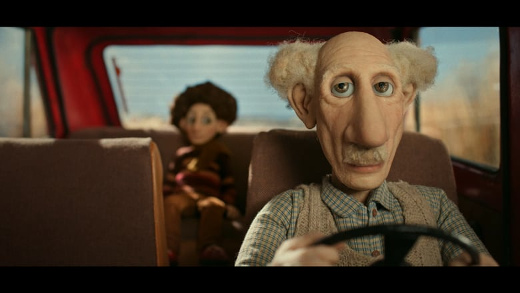
Farewell
The detailed puppetry appears impressive, it is truly hard to stop focusing on the depth and sadness of the characters' eyes or specificity of the rural pond set design. Transitions between time layers in storytelling are unpretentious though general theme of recalling memories of the grandfather and use of the symbolics of water seemed risky at least. Furthermore, the transitions clearly derive from the settings, instigated by the contemplation of the bathtub drain or water drops.
Eventually the festival tour of 2016 allowed me to dig in depths of animated film history. On each event another forgotten treasure has been displayed, but certainly screening of Marcell Jankovic's Fehérlófia at PAF examined the limits of my perception.
Here I break my principle since Jankovic's film is a feature-length but PAF encourages such attitude. Psychedelic visuals of Fehérlófia are based on spinning or kaleidoscopic compositions of transforming, multiplying or defragmentating lines, shapes and characters. A story originating from Hunnic and Avaric legends supposedly follows "rule of three" fairytale but visual experience of whirl, circulation and immersion is much more important than linear development of voice-over storytelling. The screen is engaging, yet if you loose your focus there's no way to keep up the pace of floating images that mock one's cognitive habits.
ASKING FOR DIRECTIONS
Obviously it is impossible to single out all the inspirations experienced during such intense festival trip. Animafest and Animator organized conferences attended by aspiring film scholars as well as renowned academics and filmmakers.
PAF invited over 30 international experts to share their views deriving from artistic practice, film studies, anthropology and history of culture on the general festival theme inspired by John Berger's writings: why look at the animals? Fest Anča, Etiuda&Anima and Animateka build their professional programmes on series of master classes.
As I believe, meetings with Brothers Quay, Steven Woloshen, Signe Baumane, Anita Killi, Georges Schwizgebel, Chris Landreth or Paul Bush demand autonomous coverage.

Chris Landreth @ Animateka 2016 (photo: Katja Golat / Andrej Firm)
Not to praise StopTrik too much but I hope that the attendees found in-depth meeting with Miloš Tomić and discussion on specificity of stop motion with invited filmmakers inspiring. Supertoon dedicated a lot of time and passion to bring the audience close to the living legend of Borivoj Dovniković-Bordo

StopTrik 2016 (photo credits: Michal Cernasky)
And everyday at Anibar you learn tremendously a lot about the film cultural activism, you see the actual change of spectators' behaviour and you observe construction of public sphere as work-in-progress. From the perspective of a person involved in Film Studies and a festival organizer, the most significant standpoint that crystallized in 2016 is a call for proper archiving, preparation of the festival materials based on fact-checking, construction of the arguments in discussion (either informative or academic) detached from speculation but rooted in verifiable knowledge.
On Scanner conference at Animafest Zagreb, a most prominent figure of Animation Studies, Giannalberto Bendazzi whose contribution to the field can't be overestimated, posed an argument that Fred Wolf's 1968 Oscar-winning The Box (1967) is a plagiarism of Bordo's Curiosity awarded at the 1967 Krakow Film Festival) while presenting no strong evidence that would sustain it. Definitive accusations of such kind petrify possible disputes of historical influences.
In consequence of such deliberations confused film scholars and critics may easily get lost in the labyrinths of contradictory writings, empty festival archives and non-accessible press clipping collections. No doubt that festival is a temporary celebration of contemporaneity, yet it also shapes local community, structures the process of reception of works of art, eventually serves as a source of knowledge.
The last function shall not be neglected, neither by organizers, nor visitors. Otherwise, no matter how successful, professional and impressive event we will create or attend, something of value will be missed.
Olga Bobrowska



